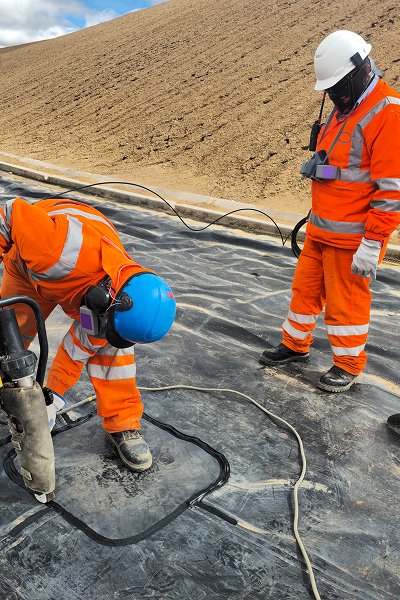Classification of geomembranes
Polyethylene (PE) geomembrane: Polyethylene geomembrane is a common type of geomembrane, which uses low-density polyethylene (LDPE) or high-density polyethylene (HDPE) as raw materials. PE geomembrane has excellent anti-seepage performance, chemical corrosion resistance and high mechanical strength, and is suitable for most geotechnical projects.
Polyvinyl chloride (PVC) geomembrane: Polyvinyl chloride geomembrane uses PVC as raw material and has good flexibility and UV resistance. It is suitable for projects with high strength requirements, such as landfills, sewage treatment and other fields.


Main properties of geomembranes
Impermeability; Physically isolate and block the flow of permeable media to prevent the penetration of water or other liquids, especially suitable for waterproofing and anti-seepage projects such as reservoirs, dams, and groundwater storage tanks.
Tensile strength; Geomembranes have high tensile strength and can withstand large external tensile forces. This makes it widely used in civil engineering, especially in places such as landfills and sewage pools that need to withstand large mechanical stresses.
Aging resistance; High-quality geomembranes have strong resistance to ultraviolet (UV) rays and can effectively resist aging caused by sunlight. Polyethylene geomembranes and polypropylene geomembranes often have good UV resistance and can maintain a long service life in long-term exposure environments.
Chemical corrosion resistance; Geomembranes have strong chemical stability and can resist the erosion of a variety of chemical substances, especially in special environments such as landfills, chemical storage pools, and mine tailings ponds.
Flexibility and plasticity: The flexibility of geomembrane allows it to adapt to complex soil environments and can be bent or folded during engineering construction to ensure a tight connection with the ground or other engineering structures to avoid the risk of leakage at the joints.
Main application areas of geomembranes
Water conservancy projects; widely used in anti-seepage dams, reservoirs, artificial lakes and other fields. It can effectively isolate the penetration between water bodies and external soil, ensuring the effective storage and utilization of water resources.
Landfills; geomembranes are mainly used to prevent the pollution of groundwater by garbage leachate. By laying geomembranes on the bottom and side walls of landfills, the contact between garbage leachate and the surrounding environment can be effectively isolated to avoid the spread of pollutants.
Sewage treatment; geomembranes are used in anti-seepage projects such as ponds, sewage pools, and wastewater treatment facilities in sewage treatment projects to prevent secondary pollution caused by sewage infiltration.
Agriculture; geomembranes are used as covering films and greenhouse films for farmland to increase the temperature, humidity and gas exchange of crop growth environments, reduce soil evaporation and water loss, and improve the efficiency of water resource utilization.
Mining projects; geomembranes are also widely used in mine anti-seepage projects, mainly used for anti-seepage isolation of mine tailings ponds to prevent harmful substances from infiltrating groundwater and soil.
Flood prevention and disaster relief: Geomembranes can be used in infrastructure construction such as dams and levees to enhance flood control capabilities and prevent soil loss or structural damage caused by floods.


Construction and installation of geomembranes
The laying of geomembranes needs to be planned according to the topography of the site, and ensure that the membrane material is laid flat without wrinkles. When laying, the joints of the membrane should be properly handled to avoid water seepage points. The joints are usually welded by heat welding or mechanical suture to ensure the sealing of the joints.
Connection and reinforcement: At the joints of geomembranes, it is necessary to ensure that the membrane material is firmly connected. Heat welding, electric welding, mechanical fixing and other methods can be used. In addition, the edges and joints of geomembranes usually need to be reinforced to improve the stability of the project.
Setting of protective layer: To protect the geomembrane from damage by external substances, a protective layer is often laid on the membrane surface, such as geotextile, gravel, etc. The protective layer can not only prevent the geomembrane from being punctured by sharp substances, but also improve its stability in long-term use.

Geomembrane is an important civil engineering material with broad application prospects. With the advancement of science and technology, the materials and performance of geomembranes are constantly being improved and enhanced. In the future, it will be widely used in more fields, especially in environmental protection, agriculture, water conservancy and other fields, with huge market potential.


